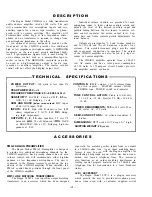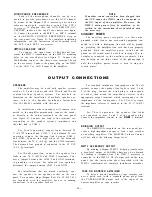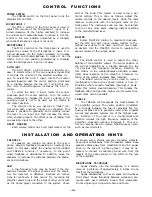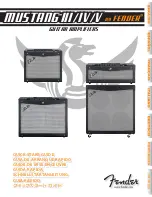
POWER SWITCH
The POWER switch on the front panel turns the
amplifier ON and OFF.
MICROPHONE I
The MIC 1 control on the front panel is used to
adjust the volume of the Microphone 1 input. It is
turned clockwise (to the higher numbers) to increase
the volume and counterclockwise to reduce it. Set the
control to the zero position (indicated by a triangle)
when the Microphone 1 input is not used.
MICROPHONE 2
The MIC 2 control on the front panel is used to
adjust the volume of the Microphone 2 input. It is
turned clockwise (to the higher numbers) to increase
the volume and counterclockwise to reduce it. Set the
control to the zero position (indicated by a triangle)
when the Microphone 2 input is not used.
AUXILIARY
The AUX l/AUX 2 control serves a two-fold
pur-
pose. It selects either of the two auxiliary inputs and
it controls the volume of the selected auxiliary in-
put. To select the AUX 1 input, rotate the control
counterclockwise past the center position (indicated
by a triangle between the two l’s). Turning this con-
trol more counterclockwise increases the AUX 1
volume.
To select the AUX 2 input, rotate the control
clockwise past the center position. Turn the control
more clockwise to increase the AUX 2 volume. If the
auxiliary input is not to be used, set the control to
the center position.
The control can be
also
used as a “fader” con-
trol when both auxiliary inputs are connected. This
makes it possible to gradually and smoothly reduce
the level of one input and then increase the other
when changing inputs. The effect is one of fading from
one auxiliary input to the other.
RESET MARKER
Each volume control has a red reset marker on the
I N S T A L L A T I O N A N D
FEEDBACK
If speakers are located too close to the micro-
phone, acoustic feedback (squealing or howling) may
result. In this case, adjust the volume, and the BASS
and TREBLE controls if necessary, to the point
where feedback is eliminated. In addition, move the
speakers to increase the distance between the speak-
ers and microphone.
HUM
A low-frequency hum may be heard if the con-
nections between the signal sources and the ampli-
fier are incorrect or defective. Recheck all connec-
tions for continuity if hum occurs. Try reversing the
amplifier power plug and the plugs of other units such
as the phono player connected in the system. Check
C O N T R O L F U N C T I O N S
skirt of the knob. This marker is used to log a par
ticular setting. This is done as follows. Adjust the
volume controls to the desired levels. Slide the reset
markers to coincide with the midpoint mark on the
front panel. The individual knob can now be returned
to zero or any other point, allowing instant resetting
to the predetermined level.
MASTER
Rotate MASTER control to maximum clockwise.
Set the MIC and AUX input volume controls to the
highest level likely to be used, and then mix inputs
as desired. Use the MASTER control to regulate the
overall volume of the output signal.
BASS
The BASS control is used to adjust the tonal
balance of the amplifier output. The center position of
the control (indicated by a triangle between the two
l’s) provides flat frequency response. Rotation of
this control in the counterclockwise direction reduces
(cuts) bass response of the amplifier. Clockwise ro-
tation of the control increases bass response.
The BASS control may also be used to remove
low-frequency noise such as phono rumble or hum. In
situations where acoustic feedback (howling) is likely,
rotate this control counterclockwise. This reduces the
feedback effect and permits higher volume levels than
would other wise be possible.
T R E B L E
The TREBLE control adjusts the tonal balance of
the amplifier output. The center position (indicated
by a triangle between the two l’s) provides flat fre-
quency response and is generally used when program
sources and speaker systems are of the highest qual-
ity. Rotation of the control in a counterclockwise
direction reduces the high frequency response of the
amplifier; clockwise rotation increases it. This con-
trol can also be used to remove high-frequency noise,
such as record scratch.
OPERATING H I N T S
for broken wires, shields and poor connector contacts.
Keep input cables away from the speaker cables. Keep
speaker cables away from transformers and AC power
lines. In the case of a phono player, it may be ne-
cessary to connect a separate ground wire from the
chassis of the phono player to the GND on the rear
of the amplifier.
MICROPHONE TECHNIQUE
Speak directly into the microphone in a normal
voice, at a distance of approximately 6 inches to one
foot from the microphone.
Speak deliberately with even speed and loudness.
Don’t shout. Pause frequently between words-and pro-
nounce each word carefully. Sound final consonants.
Do not sing-song or drop words here and there.
-6-
Summary of Contents for CHS100
Page 8: ......


























